Energy Transition Profits Are Elusive

/
Rivian’s R1T truck has a special storage compartment for golf clubs. Nothing else so eloquently describes the conundrum facing the auto industry. America is not an obvious market for EVs. It’s a vast place, so we drive greater distances. Gasoline is cheaper than in other developed countries. And we like big cars – two thirds of US sales are light trucks and SUVs.
Progressively tighter standards on CO2 emissions are pushing auto makers to develop EVs in order to be able to keep selling cars. Given US consumer tastes, those cars need to be big. But the golf storage capabilities of the R1T surely address a very narrow sliver of the market. I can attest that the parking lots of country clubs are devoid of light trucks. And the guys at Home Depot loading their trucks with lumber to build a deck are not contemplating how that new wedge will get them reliably up and down from off the green.
Moreover, golf clubs are generally politically conservative. Climate change is not a common topic on the tee box or in the bar afterwards.
The golfing light truck owner more worried about global warming than his short game is a niche market.
Nonetheless I know two, and like all my friends who own EVs they love them. But each also has a traditional car to complement their $60K Tesla or $100K Rivian. EV owners always have another car.
Seven years ago Ford fired then-CEO Mark Fields because the board felt he wasn’t moving the company aggressively enough into EVs. New management addressed the problem, and so now Ford is losing $BNs on EVs. They recently dropped plans to produce an EV SUV. The writedown could be as big as $1.9BN, and they expect to lose $5.5BN this year on EVs. While bigger gasoline-powered cars are more profitable to manufacture, the reverse is true with EVs. Batteries don’t scale easily. Ford has decided to slow their EV push.
A survey several years ago showed that car journeys are overwhelmingly short, with fewer than 5% over 30 miles. I’ve never run a car business, but it looks to me as if the auto industry is squandering substantial sums trying to build a car that covers 100% of trips, instead of producing one that does almost all of them. Range anxiety kicks in at much more than 30 miles, so although the survey doesn’t offer that detail, an EV can probably suffice for 97-98% of an owner’s trips.
Since all the EV owners I know have a second car, instead of aspiring to build an EV that renders the long distance back-up unnecessary, why don’t manufacturers offer very cheap EVs for local trips? Consumers could keep the gas-powered car in the garage, brought out infrequently for that 200 mile journey to see grandma. Offer souped-up golf carts. Or take advantage of China’s substantial support of its domestic battery manufacturing to import their cheap EVs instead of imposing 100% tariffs.
Developing countries are demanding $TNs in transfers to help them transition to low-emission energy systems. In a neat twist, by importing Chinese EVs they would be subsidizing our energy transition rather than the other way around. Transportation sector emissions would fall. The addressable market would extend beyond the virtue-signaling residents of blue counties, and golfing light truck owners.
Public policy doesn’t treat climate change as the existential threat policymakers claim it is. Otherwise, we would freely import Chinese EVs and solar panels. The Sierra Club would be calling for a Federal regulatory structure for nuclear power that enables a vast buildout. We’d be pushing our cheap natural gas on developing countries to displace coal.
The White House hails tighter emissions standards that will, “…create good-paying, union jobs leading the clean vehicle future.”
That’s fine but admit that the energy transition is outrageously expensive and competes with other priorities.
Ford, like the rest of the auto industry, is finding energy transition profits elusive. Tesla is the notable exception. Windpower is generating billions in losses (see Windpower Faces A Tempest) . The S&P Clean Energy Index has performed miserably over the past five years, returning 6.9% pa compared with 16.4% pa for the American Energy Independence Index.
If you want to make a small fortune investing in the energy transition, start with a big one.
Midstream energy infrastructure companies can take the tax credit opportunities created by the Inflation Reduction Act while also generating reliable cashflows from their existing business. They can selectively invest in carbon capture or hydrogen hubs where Federal largesse is sufficient to tip the economics into profitability. But there’s no existential threat to their traditional business, because energy transitions have historically taken decades. This one will too.
Many investors like us are concluding that pipeline companies are among the best ways to participate in the energy transition.
We have three have funds that seek to profit from this environment:

Important Disclosures
The information provided is for informational purposes only and investors should determine for themselves whether a particular service, security or product is suitable for their investment needs. The information contained herein is not complete, may not be current, is subject to change, and is subject to, and qualified in its entirety by, the more complete disclosures, risk factors and other terms that are contained in the disclosure, prospectus, and offering. Certain information herein has been obtained from third party sources and, although believed to be reliable, has not been independently verified and its accuracy or completeness cannot be guaranteed. No representation is made with respect to the accuracy, completeness or timeliness of this information. Nothing provided on this site constitutes tax advice. Individuals should seek the advice of their own tax advisor for specific information regarding tax consequences of investments. Investments in securities entail risk and are not suitable for all investors. This site is not a recommendation nor an offer to sell (or solicitation of an offer to buy) securities in the United States or in any other jurisdiction.
References to indexes and benchmarks are hypothetical illustrations of aggregate returns and do not reflect the performance of any actual investment. Investors cannot invest in an index and do not reflect the deduction of the advisor’s fees or other trading expenses. There can be no assurance that current investments will be profitable. Actual realized returns will depend on, among other factors, the value of assets and market conditions at the time of disposition, any related transaction costs, and the timing of the purchase. Indexes and benchmarks may not directly correlate or only partially relate to portfolios managed by SL Advisors as they have different underlying investments and may use different strategies or have different objectives than portfolios managed by SL Advisors (e.g. The Alerian index is a group MLP securities in the oil and gas industries. Portfolios may not include the same investments that are included in the Alerian Index. The S & P Index does not directly relate to investment strategies managed by SL Advisers.)
This site may contain forward-looking statements relating to the objectives, opportunities, and the future performance of the U.S. market generally. Forward-looking statements may be identified by the use of such words as; “believe,” “expect,” “anticipate,” “should,” “planned,” “estimated,” “potential” and other similar terms. Examples of forward-looking statements include, but are not limited to, estimates with respect to financial condition, results of operations, and success or lack of success of any particular investment strategy. All are subject to various factors, including, but not limited to general and local economic conditions, changing levels of competition within certain industries and markets, changes in interest rates, changes in legislation or regulation, and other economic, competitive, governmental, regulatory and technological factors affecting a portfolio’s operations that could cause actual results to differ materially from projected results. Such statements are forward-looking in nature and involves a number of known and unknown risks, uncertainties and other factors, and accordingly, actual results may differ materially from those reflected or contemplated in such forward-looking statements. Prospective investors are cautioned not to place undue reliance on any forward-looking statements or examples. None of SL Advisors LLC or any of its affiliates or principals nor any other individual or entity assumes any obligation to update any forward-looking statements as a result of new information, subsequent events or any other circumstances. All statements made herein speak only as of the date that they were made. r
Certain hyperlinks or referenced websites on the Site, if any, are for your convenience and forward you to third parties’ websites, which generally are recognized by their top level domain name. Any descriptions of, references to, or links to other products, publications or services does not constitute an endorsement, authorization, sponsorship by or affiliation with SL Advisors LLC with respect to any linked site or its sponsor, unless expressly stated by SL Advisors LLC. Any such information, products or sites have not necessarily been reviewed by SL Advisors LLC and are provided or maintained by third parties over whom SL Advisors LLC exercise no control. SL Advisors LLC expressly disclaim any responsibility for the content, the accuracy of the information, and/or quality of products or services provided by or advertised on these third-party sites.
All investment strategies have the potential for profit or loss. Different types of investments involve varying degrees of risk, and there can be no assurance that any specific investment will be suitable or profitable for a client’s investment portfolio.
Past performance of the American Energy Independence Index is not indicative of future returns.






Leave a Reply
Want to join the discussion?Feel free to contribute!